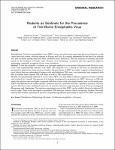Rodents as Sentinels for the Prevalence of Tick-Borne Encephalitis Virus
Achazi, Katharina
Ruzek, Daniel
Mantke, Oliver Donoso
Schlegel, Mathias
Ali, Hanan Sheikh
Wenk, Mathias
Schmidt-Chanasit, Jonas
Ohlmeyer, Lutz
Rühe, Ferdinand
Vor, Torsten
Kiffner, Christian
Kallies, René
Ulrich, Rainer
Niedrig, Matthias
Introduction: Tick-borne encephalitis virus (TBEV) causes one of the most important flavivirus infections of the central nervous system, affecting humans in Europe and Asia. It is mainly transmitted by the bite of an infected tick and circulates among them and their vertebrate hosts. Until now, TBE risk analysis in Germany has been based on the incidence of human cases. Because of an increasing vaccination rate, this approach might be misleading, especially in regions of low virus circulation. Method: To test the suitability of rodents as a surrogate marker for virus spread, laboratory-bred Microtus arvalis voles were experimentally infected with TBEV and analyzed over a period of 100 days by real-time (RT)–quantitative polymerase chain reaction. Further, the prevalence of TBEV in rodents trapped in Brandenburg, a rural federal state in northeastern Germany with autochthonous TBE cases, was determined and compared with that in rodents from German TBE risk areas as well as TBE nonrisk areas. Results: In experimentally infected M. arvalis voles, TBEV was detectable in different organs for at least 3 months and in blood for 1 month. Ten percent of all rodents investigated were positive for TBEV. However, in TBE risk areas, the infection rate was higher compared with that of areas with only single human cases or of nonrisk areas. TBEV was detected in six rodent species: Apodemus agrarius, Apodemus flavicollis, Apodemus sylvaticus, Microtus agrestis, Microtus arvalis, and Myodes glareolus. M. glareolus showed a high infection rate in all areas investigated. Discussion and Conclusion: The infection experiments proved that TBEV can be reliably detected in infected M. arvalis voles. These voles developed a persistent TBE infection without clinical symptoms. Further, the study showed that rodents, especially M. glareolus, are promising sentinels particularly in areas of low TBEV circulation.
Dateien zu dieser Publikation
Keine Lizenzangabe
Verwandte Publikationen
Anzeige der Publikationen mit ähnlichem Titel, Autor, Urheber und Thema.
-
2010-06-30ZeitschriftenartikelConfirmed Exposure to Tick-Borne Encephalitis Virus and Probable Human Cases of Tick-Borne Encephalitis in Central/Northern Anatolia, Turkey Ergünay, Koray; Saygan, Mehmet B.; Aydoğan, Sibel; Litzba, Nadine; Sener, B.; Lederer, Sabine; Niedrig, Matthias; Hasçelik, G.; Us, DürdalTick-borne encephalitis virus (TBEV) is the aetiological agent of tick-borne encephalitis (TBE), a potentially fatal central nervous system infection of humans. TBE is endemic in many areas of Europe and Asia; however, ...
-
2014-05-12ZeitschriftenartikelTick-Borne Encephalitis Virus Replication, Intracellular Trafficking, and Pathogenicity in Human Intestinal Caco-2 Cell Monolayers Yu, Chao; Achazi, Katharina; Möller, Lars; Schulzke, Jörg D.; Niedrig, Matthias; Bücker, RolandTick-borne encephalitis virus (TBEV) is one of the most important vector-borne viruses in Europe and Asia. Its transmission mainly occurs by the bite of an infected tick. However, consuming milk products from infected ...
-
2015-09-24ZeitschriftenartikelFirst Draft Genome Sequence of Balamuthia mandrillaris, the Causative Agent of Amoebic Encephalitis Detering, H.; Aebischer, Toni; Dabrowski, Piotr Wojtek; Radonić, Aleksandar; Nitsche, Andreas; Renard, Bernhard Y.; Kiderlen, AlbrechtThe free-living amoeba Balamuthia mandrillaris is a rare but highly lethal agent of amoebic encephalitis in humans and many other mammalian species. Here, we announce the first draft genome sequence of the original 1990 ...

